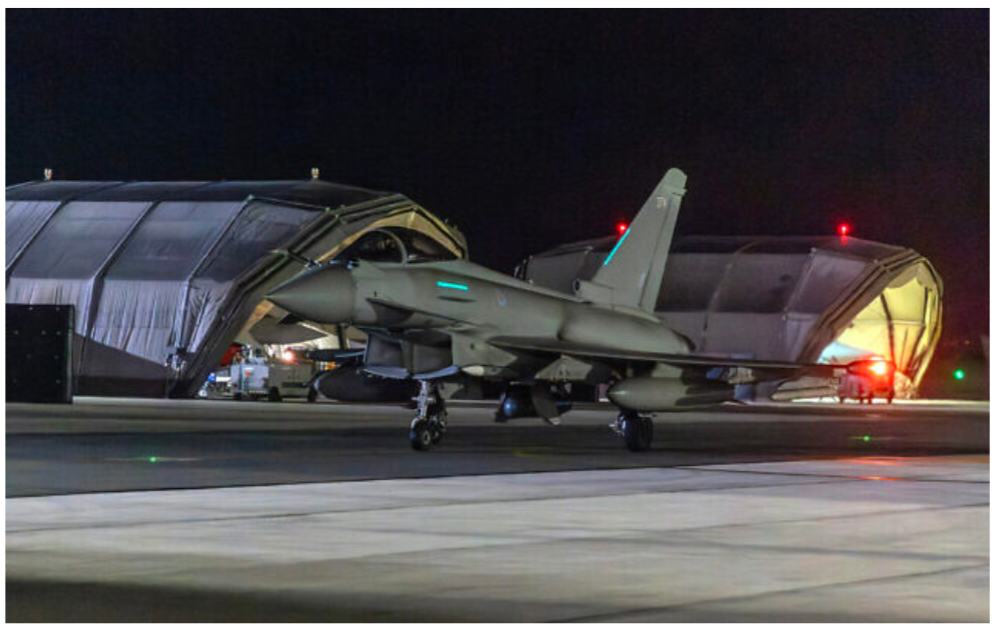A Yemeni youth holds a mock rocket during a protest following US and British forces strikes, in the Houthi-controlled capital Sanaa on January 12, 2024. (MOHAMMED HUWAIS.)
US and British military strikes on Houthi-controlled sites in Yemen over the weekend largely left intact most of the Iran-backed rebel group’s ability to fire at maritime traffic in the Red Sea, according to a report Saturday.
Two waves of US-led strikes Friday hit more than 60 targets in 28 locations in response to weeks of attacks on commercial vessels traversing a vital strait near the mouth of the Red Sea. Another missile attack on Saturday was described as “follow-on action” by the US Central Command.
Citing two US officials, The New York Times reported Saturday that the volleys had degraded some 20 to 30 percent of the Houthi’s offensive capabilities, with much of the rest hidden and out of danger.
According to the officials, who were not named, some 90% of the sites targeted were damaged or destroyed.
The attacks came after weeks of threats by Washington and London that they could take action against the Houthis in response to dozens of drone and missile attacks on ships moving through the southern Red Sea, including assaults on warships sent to protect commercial vessels. The rebel group began the attacks in support of the Hamas terror group, which Israel is battling in Gaza.

(COMBO) This combination of pictures created on January 12, 2024 shows (top) this handout satellite picture courtesy of Maxar Technologies shows a building at Taez airfield in Taez, Yemen on December 13, 2023, before airstrikes by the United States and Britain, (bottom) this handout satellite picture courtesy of Maxar Technologies shows a destroyed building at Taez airfield in Taez, Yemen on January 12, 2024, after airstrikes by the United States and Britain. (Satellite image ©2024 Maxar Technologies.)
While largely ineffective, according to Western officials, the Houthi attacks led many of the world’s largest shippers to avoid the waterway and instead sail around Africa, sending costs soaring and disrupting global trade. It’s unclear if shipping firms will again feel safe using the waterway with much of the Houthis’ capabilities intact.
Ahead of the attacks, Houthis moved or hid much of their offensive capabilities, which are largely mounted on mobile carriers.
US Air Forces Central Command said the strikes focused on the Houthis’ command and control nodes, munition depots, launching systems, production facilities and air defense radar systems. The strikes involved more than 150 precision-guided munitions including air-launched missiles by F/A-18 Super Hornets based on the USS Dwight D. Eisenhower, and Tomahawk missiles from the Navy destroyers USS Gravely and USS Mason, the Navy cruiser USS Philippine Sea, and a US submarine.
The United Kingdom said strikes hit a site in Bani allegedly used by the Houthis to launch drones and an airfield in Abbs used to launch cruise missiles and drones.
“I know we have degraded capability. I don’t believe that they would be able to execute the same way they did the other day,” Lt. Gen. Douglas Sims, director of the Joint Chiefs of Staff, said Saturday, referring to a complex missile and drone attack carried out by the Houthis on January 9.
White House spokesperson John Kirby said the initial strikes had hit the Houthis’ ability to store, launch and guide missiles or drones.
The attacks killed at least five people and wounded six, the Houthis said, vowing to retaliate.

A handout picture released by the British Ministry of Defence (MOD) on February 14, 2022 shows the return of RAF Typhoon aircraft at RAF Akrotiri in Cyprus, after striking military targets in Yemen, early on January 12, 2024. (Sgt Lee Goddard / MOD.)
According to the officials quoted by The New York Times, the US and other intelligence agencies in the West have had a tougher time than predicted finding sites to target, after years in which data collection on Yemen was largely not a main priority.
The officials said US analysts have been scrambling to find sites to target.
The US said the first wave of strikes targeted 16 sites, and the second wave another 12 sites that were identified during and immediately after those attacks.
According to the Times report, the site struck Saturday was a “reattack” of a site hit early Friday morning.
Saudi Arabia, which fought a years-long war in Yemen in support of the government-in-exile that the Houthis are fighting, has sought to distance itself from the attacks as it seeks to maintain a delicate détente with Iran and a ceasefire it has in Yemen.

People take part in a protest in the streets of the Yemeni Red Sea city of Hudeida on January 12, 2024.

